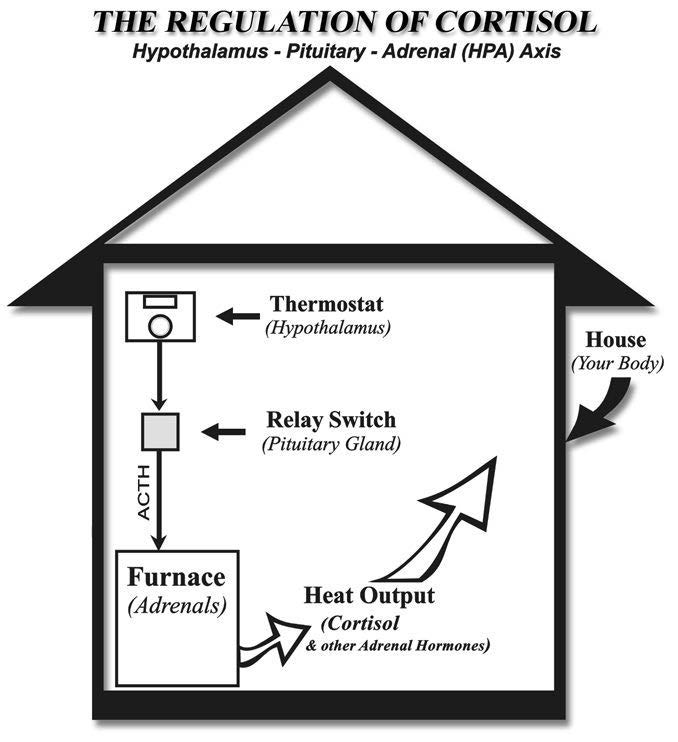By James Wilson, DC, ND, PhD
Cortisol is responsible for many life-sustaining functions. Although cortisol is secreted by the zona fasciculata in the adrenal glands, it is regulated primarily by the brain. The amount of cortisol circulating at any particular moment is regulated by a complex interaction between the hypothalamus, the pituitary gland, and the adrenal glands. This regulatory trio, often referred to as the HPA axis, operates through a negative feedback system.
The Negative Feedback System
A negative feedback system works like the thermostat in a house or apartment. The thermostat senses the heat in the room and compares it with the desired temperature at which it has been set. When the heat gets too low, the thermostat signals the relay switch to tell the furnace to ignite, sending out hot air into the room and raising the heat. When the heat has risen to the desired level, the thermostat signals the furnace to quit until more heat is needed. This cycle is called a negative feedback system because when enough heat is released, a negative signal is sent to slow or stop the input.
In the body, the hypothalamus is analogous to the thermostat, the pituitary to the relay switch, the adrenals to the furnace, and the body to the room (see the illustration, “The Regulation of Cortisol”). The amount of cortisol released is comparable to the heat released from the furnace. To a large extent, the thermostat is controlled through the demands placed on it. These demands arise from the physical situations the body has to deal with (diet, exercise, work, climate, etc.) and the reactions (emotional and physiological) to them. This negative feedback system is described below in the language of physiology.
The Physiology of Cortisol Regulation
The HPA Axis is one of the most important elements of homeostasis; the process that maintains a steady internal biochemical and physiological balance in the body. The HPA Axis adjusts cortisol levels according to the needs of the body, under normal and stressed conditions, via a hormone called the Adrenal Corticotrophic Hormone (ACTH). ACTH is secreted from the pituitary gland in response to orders from the hypothalamus and travels in the bloodstream to the adrenal cortex. There it activates cells in all three (or four) zones to produce their various hormones.
Each zone generates different hormones as end products, but the process of making all hormones in all zones begins with ACTH binding to the walls of the adrenal cells. This initiates a chain reaction of intracellular enzymes that release cholesterol within the cell. The cholesterol is then used inside the adrenal cells to manufacture pregnenolone, the first hormone in the adrenal cascade. No matter which adrenal hormone is being produced, pregnenolone is the first hormone formed in the series.
In the zona fasciculata, pregnenolone is processed to form cortisone and then cortisol. Cortisol, once manufactured, is released into circulation. It takes less than a minute after the initial stimulation by ACTH for newly synthesized cortisol to be circulating through the blood to every part of the body, including the hypothalamus, where the concentration of cortisol is being constantly measured. Your hypothalamus, in its regulatory function, analyzes and integrates input from many different external and internal sources.
This input includes information from brain centers about overall excitability, energy requirements and sensory data from the brain centers for hearing, seeing, smelling, touch and taste. Based on this information, the hypothalamus determines how much cortisol the body requires and subsequently releases hormones as messengers.
The primary hormone messenger from the hypothalamus is corticotrophin releasing factor (CRF), which signals the pituitary gland to secrete a specific amount of ACTH. Thus ACTH is sent from the pituitary to the adrenal glands to begin the process described above all over again. Alterations in ACTH levels, and hence cortisol levels, are made minute by minute using this negative feedback loop, modulated by other information received by the hypothalamus as shown in the illustration.
Original blog by Dr. James Wilson can be found here.

James L. Wilson, DC, ND, PhD, received his Ph.D. in Human Nutrition from the University of Arizona, with minors in Immunology, Microbiology, Pharmacology and Toxicology, and research in Cellular Immunology. His doctorates in Chiropractic Medicine and Naturopathic Medicine are from the Canadian Memorial Chiropractic College and the Ontario College of Naturopathic Medicine (CCNM).
As one of the 14 founding members of CCNM, now the largest Naturopathic College in the world, Dr. Wilson has long been on the forefront of alternative medicine. For over twenty-five years, he was in private practice in Canada and the United States. In 1998, Dr. Wilson coined the term ‘adrenal fatigue’ to identify below optimal adrenal function resulting from stress and distinguish it from Addison’s disease.
With a researcher’s grasp of science and a clinician’s understanding of its human impact, Dr. Wilson has helped many physicians understand the physiology behind and treatment of various health conditions. He is acknowledged as an expert on alternative medicine, especially in the area of stress and adrenal function. Dr. Wilson is a respected and sought after lecturer and consultant in the medical and alternative healthcare communities in the United States and abroad.

